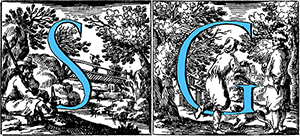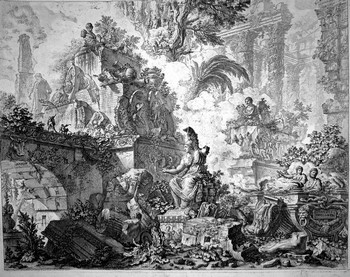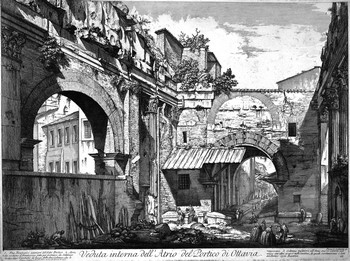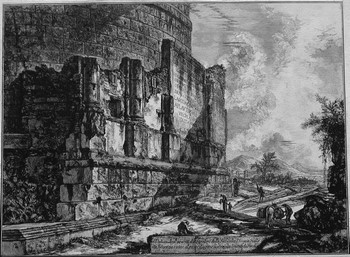
PIRANESI Giovanni Battista
(Mojano di Mestre 1720 – Rome 1778)
Venetian engraver, draftsman and architect. Son of Angelo, a Venetian stone-cutter, and Maria Lucchesi. He was introduced to the study of ancient literature and history by his brother Angelo, Carthusian monk and by his uncle Matteo Lucchesi, Magistrate of the Waters of the Venice’s republic.
Following the teachings of Giovanni Antonio Scalfarotto, Palladian architect and Carlo Zucchi, engraver and set designer, he learnt the bases of architecture, perspective and etching.
In 1740 he moved to Rome where he attended with care and commitment the workshop of the engraver and archaeologist Giuseppe Vasi, whose influence was decisive for the technical training of Piranesi.
In 1744 he returned to Venice for a short while. Here he knew the venetian views of Canaletto and Bernardo Bellotto and the first works of Tiepolo.
Back to Rome, he stayed in the city for the rest of his life, except for short journeys to Naples, Herculaneum, Pestum, Tivoli and Pompei.
Prolific etcher, he made over two thousand works, mostly of large format, depicting buildings and monuments of ancient Rome, investigated with a careful and scrupulous archaeologist eye.
On several occasions he criticized the degradation and tampering of archeological remains, underlining the need to safeguard the monumental treasure and the usefulness of a historical documentation, almost an inventory through the images.
The onset of his engraver took place with the series “Prima parte di architetture e Prospettive” of 1743, still based on the characteristics of the Venetian style view. It was followed in 1745 by the “Capricci” and then by the series “Antichità di Roma” of 1756, the beautiful plates of the “Carceri d’invenzione” of 1760, the “Magnificenza e architettura deì Romani” of 1761 and the “Diverse maniere di adornare i camini e ogni altra parte degli edifici” of 1769. His latest series was “Differenti vedute di Pestum” realized between 1777 and 1778 without the last two tables, that were finished by his son Francesco after his death. His etchings reveal ferments and tensions of romantic flavor that, though not yet fully expressed, appear already visible in the famous series “Carceri d’invenzione”.
Starting from 1748 for all lifetime, sheet after sheet, he etched numerous views of Roman palaces, squares, churches and antiquities which, although not conceived as an organic corpus, were gathered under the title of Vedute di Roma. The 2202 copperpates, from which his works were printed, have been brought to Paris by his son Francesco. These were purchased in 1835 by the Firmin-Didot publishing house and subsequently, on Pope Gregory XVI’s will, by the Calcografia Camerale (today the National Institute for Graphics in Rome).
Giovanni Battista died in 1778 and he was buried in the church of Santa Maria del Priorato within the Vatican, his only architectural work commissioned to him by Cardinale Rezzonico.















